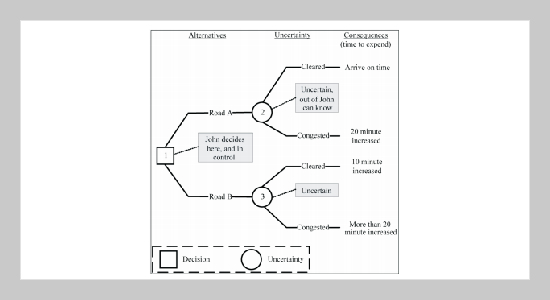REFERENCES
- [1] Andreassi, J. L., Psychophysiology: Human Behavior and Physiological Response, 4th Edition. Hillsdale, Lawrence Erlbaum, New York, U.S.A. (2000).
- [2] Russell, S. and Norvig, P., Artificial Intelligence a modern approach, 2nd edition, Prentice Hall, U.S.A. (2002).
- [3] Polya, G., How to Solve It, Doubleday Anchor, NY, U.S.A. (1957).
- [4] McGhee, P., Thinking psychologically, Palgrave, Basingstoke (2001).
- [5] Hammond and John, S., Smart Choices: A Practical Guide to Making Better Decisions, Harvard Business School Press, Boston, U.S.A. (1999).
- [6] Hogarth, R. M., Judgement and Choice, Second Edition, John Wiley & Sons, New York, U.S.A. (1987).
- [7] Moore, P. G., “The Manager Struggles with Uncertainty,” Journal of the Royal Statistical Society, Series A, Vol. 140, pp. 129148 (1977).
- [8] Wang, Y., Liu, D. and Ruhe, G., “Formal Description of the Cognitive Process of Decision Making,” IEEE International Conference on Cognitive Informatics (2004).
- [9] Osborne, M. and Rubinstein, A., A Course in Game Theory, MIT Press, U.S.A. (1994).
- [10] Kevin, B., Korb, A. E. and Nicholson, Bayesian Artificial Intelligence, Chapman & Hall/CRC, London, England (2003).
- [11] Edward, W. and Fasolo, B., “Decision Technology”, Annual Review of Psychology, Vol. 52, pp. 581606 (2001).
- [12] Tecce, J. J., Psychology, Physiology and Experimental. In McGraw-Hill Yearbook of Science and Technology, New York, U.S.A. (1992).
- [13] Vick, R. M. and Ikehara, C. S., “Methodological Issues of Real Time Data Acquisition from Multiple Sources of Physiological Data,” Proceedings of the 36th Hawaii International Conference on System Sciences, Hawaii, U.S.A. (2002).
- [14] Ritter, W. and Vaughan, H. G., “Orienting and Habituation to Auditory Stimuli: A Study of Short Term Changes in Average Evoked Responses,” Electroencephalography and Clinical Neurophysiology, Vol. 25, pp. 550556 (1968).
- [15] Rohrbaugh, J. W. and Donchin, E., “Decision Making and the P300 Component of the Cortical Evoked Response,” Perception and Psychophysics, Vol. 15, pp. 368374 (1974).
- [16] Cacioppo, J. T. and Bush, L. K., “Microexpressive Facial Actions as a Function of Affective Stimuli: Replication and Extension,” Personality and Social Psychology Bulletin, Vol. 18, pp. 515526 (1990).
- [17] Duffy, E., Activation and Behavior, Wiley, New York, U.S.A. (1996).
- [18] Fowles, D. C., “The Eccrine System and Electrodermal Activity,” Psychophysiology, pp. 5196, Guilford Press, New York, U.S.A. (1986).
- [19] Young, L. R. and Sheena, D., “Survey of Eye Movement Recording Methods,” Behavior Research ethods & Instrumentation,series. 7, Vol. 5, pp. 397429 (1975).
- [20] Sternberg, R. J., Handbook of creativity, Cambridge: Cambridge University Press (1998).
- [21] Guyton, A. C., Basic Human Physiology: Normal Function and Mechanisms of Disease, Saunders, Philadephia, U.S.A. (1977).
- [22] Lowenstein, O. and Loewenfield, I. E., Muscular mechanisms, Academic Press, New York, U.S.A. (1962).
- [23] Wnek. G. and Bowlin, G. R., “Eye Tracking: Research Areas and Applications,” Encyclopedia of Biomaterials and Biomedical Engineering, Department of Psychology, Stanford University, USA (2004).
- [24] Tversky, A. and Kahneman, D. “Availability: A Heuristic for Judging Frequency and Probability,” Cognitive Psychology, Vol. 5, pp. 207232 (1973).
- [25] Yarbus, A. L., Eye Movements and Vision, Plenum, New York, U.S.A. (1967).
















